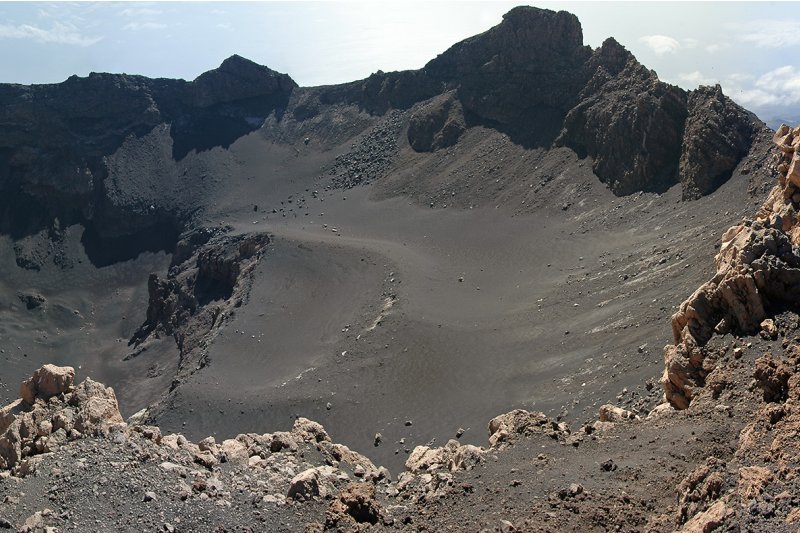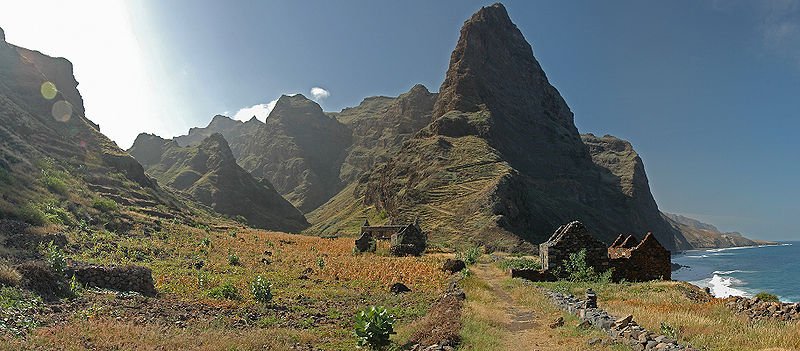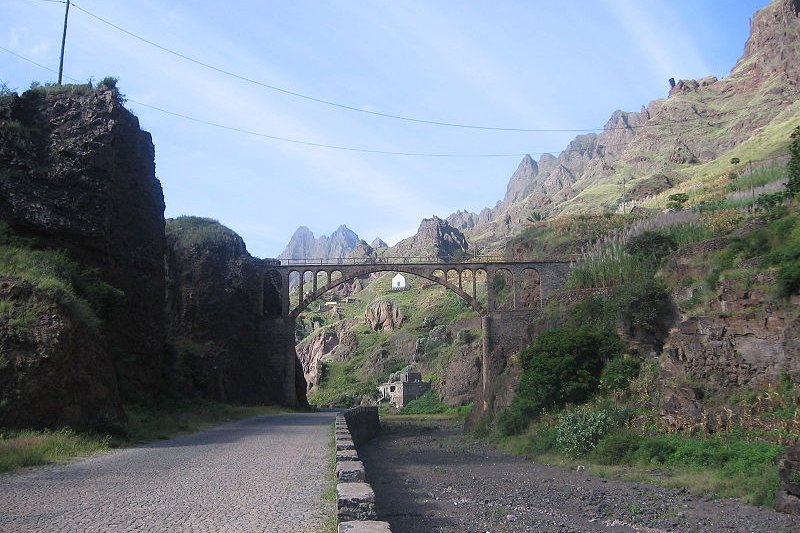 Crater of Pico de Fogo, Cape Verde
Crater of Pico de Fogo, Cape VerdeSource: https://commons.wikimedia.org/wiki/File:Pico_de_Fogo_Krater.jpg
Author: Kogo

Cape Verde is an island nation in the central part of the Atlantic Ocean. Comprising an archipelago of some 10 islands, the Republic of Cape Verde is about 540 km from the coast of Western Africa. The islands have a total area of 4,033 sq km (1,557 sq mi). The capital and biggest city is Praia.
Cape Verde has a population of about 570,000 (2011 estimate). Its official language is Portuguese, although the population mostly speak Cape Verdean Creole. The country observes Cape Verde Time, which is one hour behind Coordinated Universal Time. Traffic moves on the right side of the road here. The phone IDD code is +238. Electricity is 220V 50Hz using European sockets.
 Steep coast near Forminguinhas, Santo Antão, Cape Verde
Steep coast near Forminguinhas, Santo Antão, Cape VerdeSource: https://commons.wikimedia.org/wiki/File:Canyon_Forminguinhas.jpg
Author: Kogo

The official currency of Cape Verde is the Cape Verdean escudo (CVE). In 2009, Cape Verde had a nominal GDP of $1.768 and a per capita nominal GDP of $3,444. The per capita GDP at purchasing power parity was $3,587.
Cape Verde was uninhabited when Italian and Portuguese navigators discovered it in 1456. According to the Portuguese, the islands were first discovered by Genoese-born Antonio de Noi, who was later made the governor of Cape Verde by King Afonso V of Portugal. Portuguese settlers began arriving in newly established Santiago in 1462.
 Aqueduto Ribeira Grande, Cape Verde
Aqueduto Ribeira Grande, Cape VerdeSource: https://commons.wikimedia.org/wiki/File:AquedutoRibeiraGrande.JPG
Author: CorreiaPM

In the 16th century Cape Verde became a thriving slave port. It was occasionally ransacked by pirates, particularly in the 18th century. That, along with the decline in slave trade, brought an end to the islands' early prosperity.
In an attempt to suppress nationalism, the Portuguese elevated Cape Verde from colony to an oversea province of Portugal in 1951. A group of Cape Verdeans and Guineans formed an armed rebellion group called PAIGC (Partido Africano da Independência da Guiné e Cabo Verde) which waged a guerilla warfare against the Portuguese authorities. This led to the independence of Cape Verde from Portugal on 5 July, 1975. Originally a single-party state, Cape Verde had its first multi-party elections in 1991.
Planning your visit to Cape Verde
Most visitors require a visa. You are expected to have one done if there is a Cape Verde embassy in your country. Otherwise a visa-upon-arrival can be purchased.Cape Verde gets international flights connecting it mostly with destinations in Europe and Africa. Four of its major islands have international airports.
Places of Interest in Cape Verde
- Praia - capital
- Assomada
- Brava
- Espargos
- Mindelo
- Ribeira Grande
- Santa Maria
World Heritage Sites in Cape Verde
Cape Verde ratified the World Heritage Convention on 28 April, 1988. As of August 2010, it has one World Heritage Site, in the Cultural category. Cape Verde has another five sites on the World Heritage Tentative List.-
Cultural
- Cidade Velha, Historic Centre of Ribeira Grande (2009)
- Le Plateau de la ville de Praia (2004)
- La Saline de Pedra Lume (2004)
- Cova e Montantes de Ribeiras da Torre et do Paul (2004)
- Ville de Sao Filipe (2004)
- Camp de concentration de Tarrafal (2004)
 Latest updates on Penang Travel Tips
Latest updates on Penang Travel Tips
 Discover with Timothy YouTube Channel
Discover with Timothy YouTube Channel
 PG Food Channel
PG Food Channel
 Learn Penang Hokkien YouTube Channel
Learn Penang Hokkien YouTube Channel
 SojiMart Videos
SojiMart Videos
Latest from Discover with Timothy: Gurney Bay - what to see and do there
About this website

Hello and thanks for reading this page. My name is Timothy and my hobby is in describing places so that I can share the information with the general public. My website has become the go to site for a lot of people including students, teachers, journalists, etc. whenever they seek information on places, particularly those in Malaysia and Singapore. I have been doing this since 5 January 2003, for over twenty years already. You can read about me at Discover Timothy. By now I have compiled information on thousands of places, mostly in Peninsular Malaysia and Singapore, and I continue to add more almost every day. My goal is to describe every street in every town in Malaysia and Singapore.
Robbie's Roadmap
- Episode 1: Robbie's Journey to Financial Freedom
- Episode 2: Lost in America
- Episode 3: The Value of Money
- Episode 4: The Mentor
- Episode 5: The Thing that Makes Money
- Episode 6: The walk with a Billionaire
- Episode 7: The Financial Freedom Awakening
- Episode 8: Meet Mr Washington
- Episode 9: The Pizzeria Incident
Copyright © 2003-2024 Timothy Tye. All Rights Reserved.


 Go Back
Go Back